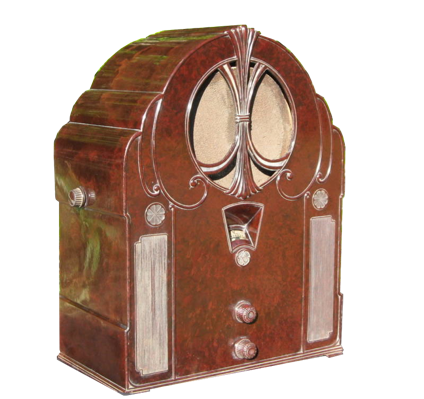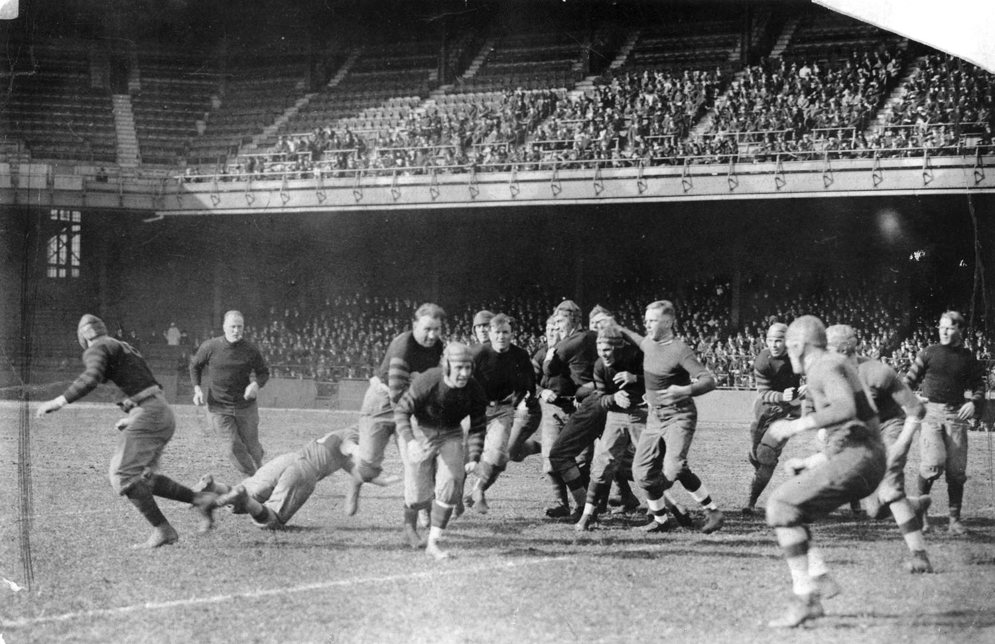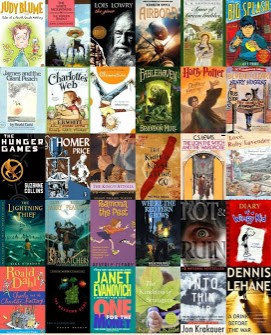Entertainment Then
Lesiure Then

In the 1930s, people loved to play board games. Many games that are widely played today were invented in this decade. Some include Sorry! (1934), Scrabble (1938), and even Monopoly (1933)! In addition, songs were being spread by the selling of sheet music, Vaudeville (a kind of play), and radio. TV was just becoming a thing, so families often spent the evening listening to the radio. TV in the early 1930s was mechanical or electro-mechanical, but later in the decade, the first fully electric television sets were being experimented with.

The most popular sport in the U.S. from this time period was football. When the local team won a game, it was often celebrated by the whole community. In addition, children back then enjoyed games that we still use today such as tag and hide-and-seek.
Motion Picture Then

The first films were made in the mid to late 1880's. Back then, people would have to individually view films by looking through a device called a kinteoscope, invented by Thomas Edison. By the 1910's, people would watch them in a movie theater called a nickelodeon.
In 1916, the first version of Technicolor was first invented. They could use two colors: red and green. They could be blended together to create different shades, too, But in 1928, the "three-strip" system proved to be even better. They were made by soaking three strips of different color films in dye, then putting them together. The first movie made completely with this technique, along with a synchronized score and sound effects, was The Viking (1929). After that, many "talkie" films were made with all of its sound completely synchronized.
In 1931, an improvement was made that removed much of the grain that resulted from this method. Some of these improved films included Manhattan Parade (1932), Doctor X (1932), and Mystery of the Wax Museum (1933). Unfortunately, around this time, The Great Depression hurt the film industry. This caused several companies, like Paramount and Metro-Goldwyn to cancel their upcoming color releases.

Soon, Disney was also making their films in color. Their first color production was a Silly Symphony, Flowers and Trees (1932). They used the improved version of Technicolor, and continued to make all their other Silly Symphonies with Technicolor. Merian C. Cooper, the director of King Kong, said that he never wanted to make another film in black and white after seeing one. After 1937, when an even better improved version of Technicolor especially for cartoons was invented, Disney adapted to make their films with it. It created its first feature-length film, Snow White and the Seven Dwarves (1937) with it, and used it thereafter for a long time until it improved.
Not soon after the Great Depression, Hollywood was still wary about making their live-action films in Technicolor. After The World Outside (1934), Hollywood continued to film in Technicolor. Technicolor did, however, have many difficulties. In The Wizard of Oz (1937), there was a huge required amount of lighting, and the heavier-clothed actors had to have an increased water intake, and some even claimed to have gotten permanent eye damage! In addition, it costed lots to send film to Technicolor to dye it. That is how another company, Eastman Kodak (known now as Kodak), attracted clients to their less expensive method that would allow more compact film of only 35 millimeters.
Reading Then

The Great Depression was one of the highest points in terms of readership. Many people became authors and made money to do more than support a family. Boys prefered action comics such as Action Comics and Detective Comics. Action Comics included Superman, which made its debut in 1938. Detective Comics introduced Batman in 1937. Detective Comics is now known as DC Comics.

Mystery novels were the most popular for most people. Other popular books during the Depression included hopeful stories about ending the Depression, as well as hard-luck stories about unfortunate people during the depression. In addition, popular books today that were written in the 1930s included The Hobbit (1937), The Hardy Boys and Nancy Drew (all decade), the Little House books (1932-1939), Mr. Popper's Penguins (1938), and many more.
Lesiure Then

In the 1930s, people loved to play board games. Many games that are widely played today were invented in this decade. Some include Sorry! (1934), Scrabble (1938), and even Monopoly (1933)! In addition, songs were being spread by the selling of sheet music, Vaudeville (a kind of play), and radio. TV was just becoming a thing, so families often spent the evening listening to the radio. TV in the early 1930s was mechanical or electro-mechanical, but later in the decade, the first fully electric television sets were being experimented with.

The most popular sport in the U.S. from this time period was football. When the local team won a game, it was often celebrated by the whole community. In addition, children back then enjoyed games that we still use today such as tag and hide-and-seek.
Motion Picture Then

The first films were made in the mid to late 1880's. Back then, people would have to individually view films by looking through a device called a kinteoscope, invented by Thomas Edison. By the 1910's, people would watch them in a movie theater called a nickelodeon.
In 1916, the first version of Technicolor was first invented. They could use two colors: red and green. They could be blended together to create different shades, too, But in 1928, the "three-strip" system proved to be even better. They were made by soaking three strips of different color films in dye, then putting them together. The first movie made completely with this technique, along with a synchronized score and sound effects, was The Viking (1929). After that, many "talkie" films were made with all of its sound completely synchronized.
In 1931, an improvement was made that removed much of the grain that resulted from this method. Some of these improved films included Manhattan Parade (1932), Doctor X (1932), and Mystery of the Wax Museum (1933). Unfortunately, around this time, The Great Depression hurt the film industry. This caused several companies, like Paramount and Metro-Goldwyn to cancel their upcoming color releases.

Soon, Disney was also making their films in color. Their first color production was a Silly Symphony, Flowers and Trees (1932). They used the improved version of Technicolor, and continued to make all their other Silly Symphonies with Technicolor. Merian C. Cooper, the director of King Kong, said that he never wanted to make another film in black and white after seeing one. After 1937, when an even better improved version of Technicolor especially for cartoons was invented, Disney adapted to make their films with it. It created its first feature-length film, Snow White and the Seven Dwarves (1937) with it, and used it thereafter for a long time until it improved.
Not soon after the Great Depression, Hollywood was still wary about making their live-action films in Technicolor. After The World Outside (1934), Hollywood continued to film in Technicolor. Technicolor did, however, have many difficulties. In The Wizard of Oz (1937), there was a huge required amount of lighting, and the heavier-clothed actors had to have an increased water intake, and some even claimed to have gotten permanent eye damage! In addition, it costed lots to send film to Technicolor to dye it. That is how another company, Eastman Kodak (known now as Kodak), attracted clients to their less expensive method that would allow more compact film of only 35 millimeters.
Reading Then

The Great Depression was one of the highest points in terms of readership. Many people became authors and made money to do more than support a family. Boys prefered action comics such as Action Comics and Detective Comics. Action Comics included Superman, which made its debut in 1938. Detective Comics introduced Batman in 1937. Detective Comics is now known as DC Comics.

Mystery novels were the most popular for most people. Other popular books during the Depression included hopeful stories about ending the Depression, as well as hard-luck stories about unfortunate people during the depression. In addition, popular books today that were written in the 1930s included The Hobbit (1937), The Hardy Boys and Nancy Drew (all decade), the Little House books (1932-1939), Mr. Popper's Penguins (1938), and many more.



